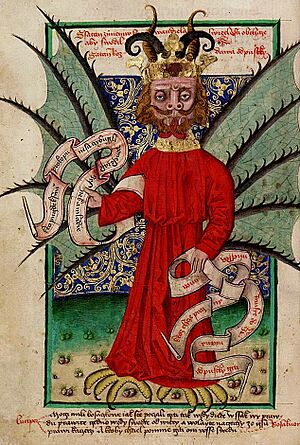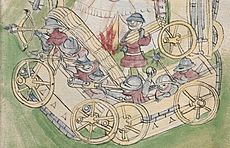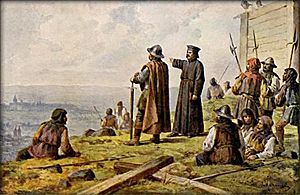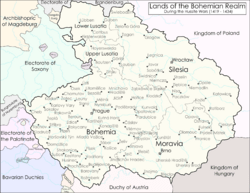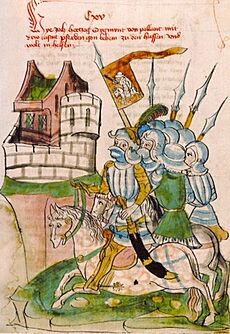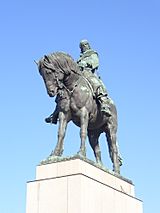Hussite Wars facts for kids
Quick facts for kids Hussite Wars |
|||||||
|---|---|---|---|---|---|---|---|
| Part of the European religious wars and the Crusades | |||||||
 Battle of Hussites and Catholic crusaders, Jena Codex, 15th century |
|||||||
|
|||||||
| Belligerents | |||||||
|
Bohemia & Moravia:
Allies: Polish–Hussite invasion of Prussia (1433): Poland: |
Splitted taborite group: Radical Picards/Neo-Adamites |
||||||
| Commanders and leaders | |||||||
Allies of the Polish–Hussite invasion of Prussia:
Supporters:
|
|
||||||
The Hussite Wars, also known as the Bohemian Wars, were a series of civil wars fought in Central Europe. These wars lasted from 1419 to 1434. They involved the Hussites, a Christian movement in Bohemia, and the combined forces of the Catholic Church and European rulers.
The conflict began after Jan Hus, a religious reformer, was executed in 1415. He was considered a heretic by the Catholic Church. King Wenceslaus IV of Bohemia tried to stop the Hussite movement. However, it continued to grow.
After King Wenceslaus IV died, tensions increased. In Prague and other Bohemian cities, Catholic Germans were forced to leave. Wenceslaus's brother, Sigismund, became the new king. He was very upset by the spread of Hussitism.
Sigismund received permission from the Pope to start a crusade against the Hussites. Many crusaders from across Europe joined the fight. They initially captured Prague. However, the Hussites fought back and took most of their land back. This first crusade failed.
Later, Jan Žižka became the leader of the Hussite army. Despite more crusades launched by the Pope, the Hussites continued to win battles. The wars finally ended in 1434. The moderate Hussites, called Utraquists, defeated the more radical Taborites. The Hussites then agreed to accept the authority of the King of Bohemia and the Catholic Church. In return, they were allowed to practice their own religious customs.
The Hussite Wars were important for their use of early hand-held firearms. They also famously used wagon forts, which were mobile defenses made from wagons.
Contents
Why the Hussite Wars Started
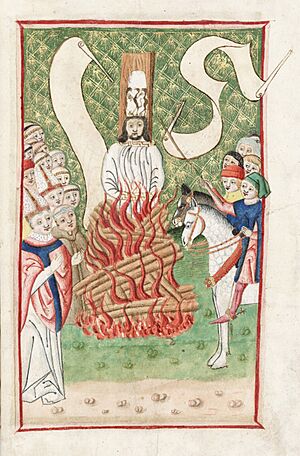
The Hussite Wars began because of religious disagreements and political tensions. A priest and scholar named Jan Hus started speaking out around 1402. He believed the church and the Pope were corrupt. Hus also supported the ideas of an English theologian, John Wycliffe. Many people in Bohemia listened to Hus's teachings.
The church saw many of Wycliffe's ideas as heresy. In 1411, a leader called "Antipope" John XXIII announced a "crusade." This was to raise money by selling "indulgences" (pardons for sins). Hus strongly spoke against this, quoting Wycliffe. This made the church even more upset but gained Hus much support in Bohemia.
In 1414, Sigismund of Hungary called the Council of Constance. Its goal was to fix problems in the church. Jan Hus went to the Council, promised safety by Sigismund. But he was arrested, put on trial, and executed on July 6, 1415.
The nobles and knights of Bohemia and Moravia were very angry. They sent a strong protest to the Council, condemning Hus's execution. Sigismund, who was King of the Romans, was furious. He believed Hus was a heretic. He threatened to punish all Hussites, which made the people even angrier.
The Hussite Movement Divides
Trouble started in Bohemia, and many Catholic priests were forced to leave their churches. The Hussites soon split into two main groups. Jan Hus had accepted the idea of Utraquism before his death. This meant that people should receive communion with both bread and wine.
This idea became central for the moderate Hussites. They were known as Utraquists or Calixtines. The more extreme Hussites were called Taborites. They were named after the town of Tábor, which became their main center. Another group was called Orphans after their leader Jan Žižka died.
King Wenceslaus tried to stop the Hussite movement. Many Hussites left Prague, led by Mikuláš of Hus. They held meetings and prepared for war. On July 30, 1419, a Hussite group attacked the New Town Hall in Prague. They threw the king's representatives out of the windows. This event is known as the first "Defenestration of Prague." King Wenceslaus died shortly after this event.
Fighting Begins in Bohemia
The death of King Wenceslaus caused more problems in Prague and Bohemia. Many Catholics, especially Germans, were forced out of Bohemian cities. Wenceslaus's wife, Sophia of Bavaria, tried to take control of Prague with hired soldiers. This led to heavy fighting.
After much damage, a truce was made on November 13. Nobles who supported the Hussites but also the queen tried to make peace with Sigismund. The people of Prague agreed to give back the Vyšehrad castle. Jan Žižka disagreed with this peace. He left Prague and went to southern Bohemia.
Žižka defeated the Catholics at the Battle of Sudoměř on March 25, 1420. This was the first major battle of the Hussite Wars. After this victory, Žižka moved to Tábor. This new settlement became the main base for the most radical Hussites.
Tábor became a strong center for the Hussites. They believed in only two sacraments: Baptism and Communion. They rejected most of the Catholic Church's ceremonies. Tábor had a very democratic government. Four captains were chosen, including Žižka. They set up strict military rules.
Hussite War Tactics and Weapons
The Hussite Wars were famous for new military tactics and weapons. In the late 1300s and early 1400s, firearms were mostly used in sieges. They were heavy and not very accurate. However, they were cheap to make and effective against armor.
When the Hussite revolt started in 1419, their soldiers were mostly ordinary people. They used farm tools and weapons taken from castles. Early firearms were very useful because they didn't need much training or physical strength.
Wagon Forts and Firearms
The Hussites first used firearms with their "wagon forts." These were defensive walls made from wagons. In early battles, like the Battle of Sudoměř in 1420, Žižka used wagon forts to stop enemy cavalry. Firearms shot from behind the wagons were very effective.
After these successes, Žižka ordered many war wagons to be built. He also ordered new firearms that were better for open battles. At first, the Hussites used wagons and firearms for defense. The wagons stayed still, and firearms broke enemy charges.
In November 1421, Žižka used wagons and firearms in a new way. He used them while moving to cover his retreating troops. The first time firearms played a main role in an attack was at the Battle of Kutná Hora. Žižka attacked the enemy camp at night with a moving wagon wall. Shooting from the moving wagons was very effective and scary for the enemy.
New Laws and Weapon Names
In 1421, a new law was made. All citizens had to join the army if called by the government. This was the first time in medieval Europe that people fought for their country, not just for a lord or the church.
Firearms improved quickly during the Hussite Wars. Owning a firearm became common for ordinary people. The Hussite word for a hand-held firearm, píšťala, later became the English word "pistol." The word for a Hussite cannon, houfnice, led to the English word "howitzer." Other Hussite firearms included the hákovnice (a heavier infantry weapon) and the tarasnice. They also used bombarda (mortars) and dělo (cannons).
First Anti-Hussite Crusade
After his brother Wenceslaus died, Sigismund claimed the Bohemian throne. He was a strong supporter of the Catholic Church. Pope Martin V helped him by calling a crusade on March 17, 1420. This crusade aimed to destroy the Hussites in Bohemia.
Sigismund and many German princes arrived at Prague on June 30 with a huge army. They tried to besiege the city. The Hussites then made their demands in a document called the "Four Articles of Prague." These articles were:
- The word of God should be preached freely by priests.
- Communion should be given with both bread and wine to all faithful Christians.
- The church should not own so much wealth and worldly goods.
- All serious sins should be punished by those in charge.
King Sigismund rejected these articles. This was mainly because the Pope's representatives thought they would weaken the Pope's power. So, the fighting continued. Sigismund was defeated at the Battle of Vítkov Hill in July 1420.
Even though Sigismund left Prague, his troops still held two castles, Vyšehrad and Hradčany. The people of Prague besieged Vyšehrad. Sigismund tried to help the castle but was defeated by the Hussites on November 1. The castles then surrendered. Soon after, almost all of Bohemia was controlled by the Hussites.
Later Crusades and Hussite Raids
The Hussites faced internal problems after their victory. A priest named Jan Želivský gained much power over the common people in Prague. In Tábor, Žižka had to stop a radical religious group.
Soon, a new crusade was launched against the Hussites. A large German army entered Bohemia in August 1421. They tried to besiege the town of Žatec. But when they heard the Hussite army was coming, the crusaders retreated. Sigismund arrived in Bohemia later that year. He took Kutná Hora but was defeated by Jan Žižka at the Battle of Deutschbrod on January 6, 1422.
Polish and Lithuanian Support
Poland sometimes helped the Hussites. Jan Žižka offered the Bohemian crown to King Władysław II Jagiełło of Poland, but he refused. Then it was offered to Władysław's cousin, Vytautas, the Grand Duke of Lithuania. Vytautas accepted, but only if the Hussites rejoined the Catholic Church.
In 1422, Žižka accepted Prince Sigismund Korybut of Lithuania as Bohemia's ruler for Vytautas. Korybut was recognized by the moderate Hussites. But he couldn't get the Hussites to rejoin the church. He even fought against the Taborites to try and force them.
In 1423, Władysław II and Vytautas made a peace treaty with Sigismund. They called Korybut back to Lithuania. After Korybut left, a civil war broke out among the Hussites. The Taborites fought against the more moderate Utraquists. Žižka led the Taborites to victory at the Battle of Hořice in April 1423.
More Crusades and Hussite Victories
The Pope tried again to launch a crusade against Bohemia, but it failed. Poles and Lithuanians did not want to attack the Czechs. Germany had its own problems. The King of Denmark also left. The Hussites were free from outside threats for a while. They invaded Moravia, where many people supported them.
After Žižka died in October 1424, Prokop the Great took command of the Taborites. In 1426, Hussite forces led by Prokop and Sigismund Korybut defeated invaders at the Battle of Aussig.
Despite this, Pope Martin V believed the Hussites were weaker. He called another crusade in 1427. Cardinal Henry Beaufort of England led the crusader forces. But the crusaders were defeated again at the Battle of Tachov. The Hussites then invaded parts of Germany several times.
The "Glorious Rides"
During the Hussite Wars, the Hussites launched raids into neighboring countries. They called these raids Spanilé jízdy, meaning "glorious rides." Under the leadership of Prokop the Great, Hussites invaded Silesia, Saxony, Hungary, and other areas.
These raids were meant to stop countries from sending soldiers to fight against the Hussites. However, the raids did not fully achieve this goal. These countries continued to supply soldiers for the crusades.
In 1433, a Hussite army of 7,000 men helped the Poles in a war against the Teutonic Order. They marched through Prussia and reached the Baltic Sea. There, they celebrated their victories. This showed that only the ocean could stop the Hussites.
Peace Talks and Final Battle
The Hussites' many victories made it clear that they could not be defeated by force. German princes also wanted peace. They worried that Hussite ideas might spread to their own lands. Many Hussites, especially the moderate Utraquist clergy, also wanted peace.
Negotiations began at the Council of Basel in 1431. The Catholic Church reluctantly allowed the Hussites to attend. Before the talks, the Church made one last attempt to defeat the Hussites. This led to the fifth crusade.
On August 1, 1431, a large crusader army crossed into Bohemia. They were led by Frederick I, Elector of Brandenburg and Cardinal Julian Cesarini. On August 8, they began to besiege the town of Domažlice. On August 14, a Hussite army arrived, led by Prokop the Great. They completely defeated the crusaders at the Battle of Domažlice. Legend says that when the crusaders saw the Hussite banners and heard their battle hymn, "Ktož jsú boží bojovníci" ("Ye Who are Warriors of God"), they immediately ran away.
Defeat of Radical Hussites
On October 15, 1431, the Council of Basel officially invited the Hussites to talks. A Hussite group, including Prokop, arrived in Basel in January 1433. No agreement was reached at first. But changes in Bohemia's political situation eventually led to a settlement.
In 1434, war broke out again between the moderate Utraquists and the radical Taborites. On May 30, 1434, the Taborite army was completely defeated at the Battle of Lipany. Both Prokop the Great and Prokop the Lesser died in this battle. The Taborite army was almost completely destroyed.
The Hussite movement in Poland also ended. Polish royal troops defeated the Hussites at the Battle of Grotniki in 1439. This marked the end of the Hussite Wars.
Peace Agreement and Its Impact
The moderate Hussites gained power and worked for a compromise. They wrote down their demands in a document called "the compacts." The Catholic Church accepted these with some small changes. The compacts stated:
- Holy Communion should be given with both bread and wine to all Christians in Bohemia and Moravia.
- All serious sins must be punished.
- God's word should be preached freely and truthfully by priests.
- Priests should not own worldly possessions.
On July 5, 1436, the compacts were officially accepted and signed in Jihlava. King Sigismund, Hussite leaders, and Catholic Church representatives were all there. However, the Catholic Church refused to recognize John of Rokycan as the archbishop of Prague.
After the Wars
The Utraquist faith remained the official church in Bohemia for a long time. This lasted until 1620, when all non-Catholic services were banned. The Taborite group never recovered from their defeat at Lipany. After their town of Tábor was captured in 1452, Utraquist worship was established there.
The Moravian Brethren continued some Taborite traditions. In the 1400s and 1500s, they were strong opponents of Rome in Bohemia. Later, many Utraquists adopted ideas from Martin Luther and John Calvin. By the end of the 1500s, Hussite followers were generally called "Protestants."
The Hussite Wars left Bohemia badly damaged. The population of the Czech lands dropped significantly between 1400 and 1526. Neighboring areas in Germany were also left very poor. This poverty contributed to a peasant uprising in Würzburg in 1476.
In 1466, Pope Paul II banned Catholics from serving the Hussite king, George of Poděbrady. In 1468, the king of Hungary, Matthias Corvinus, invaded Bohemia. He claimed he wanted to bring Bohemia back to Catholicism. Some Czech Catholic nobles chose Matthias as their king. But Bohemia itself remained loyal to George of Poděbrady. The religious peace of Kutná Hora in 1485 finally ended the long religious conflicts in the Czech lands.
See also
 In Spanish: Guerras husitas para niños
In Spanish: Guerras husitas para niños
- Bartholomaeus of Drahonice
- German Peasants' War
- Schmalkaldic War
- The Slav Epic (Painting: "The meeting at Křížky: Sub utraque")
Images for kids


